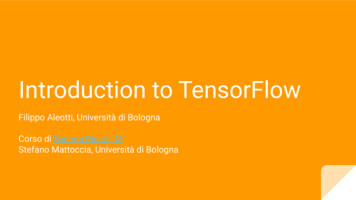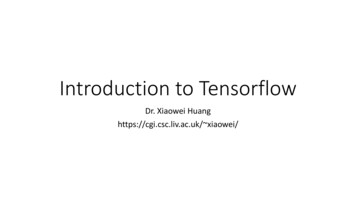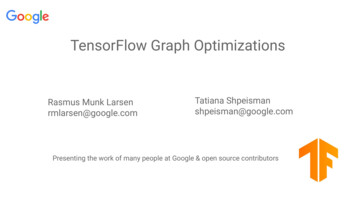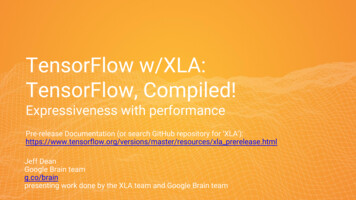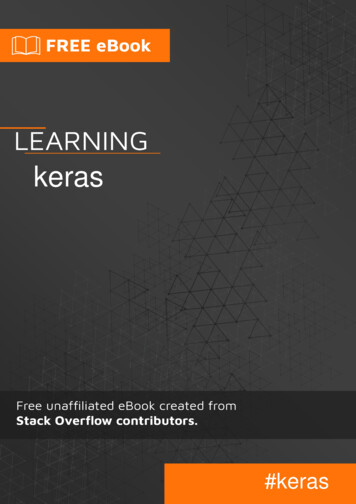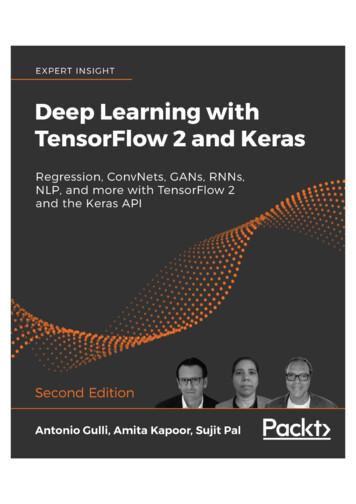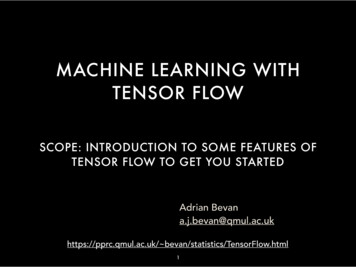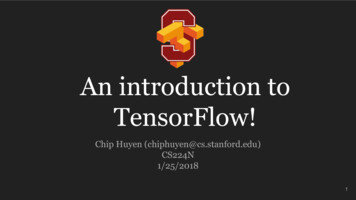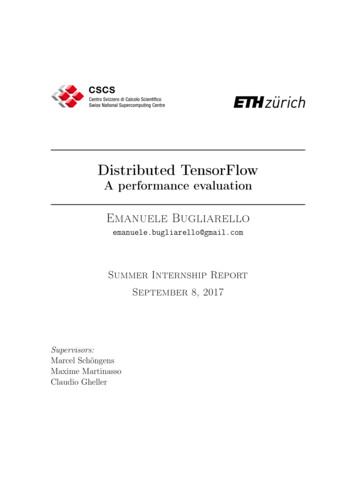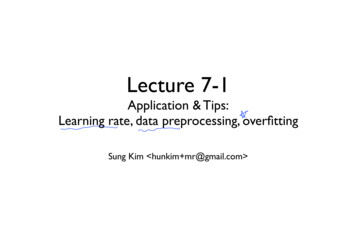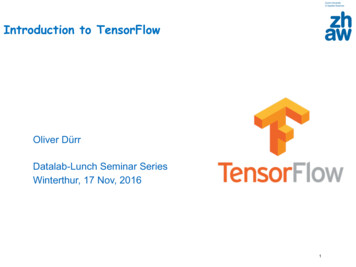
Transcription
Introduction to TensorFlowOliver DürrDatalab-Lunch Seminar SeriesWinterthur, 17 Nov, 20161
AbstractIntroduc)on to TensorFlowTensorFlow is a mul/purpose open source so2ware library for numericalcomputa/on using data flow graphs. It has been designed with deep learning in mindbut it is applicable to a much wider range of problems.In this tutorial I will cover the very basics of TensorFlow not going much into deeplearning at all. TensorFlow can be used from many programming languages. I willgive simple examples, such as linear regression, showing the python API as well asthe recent interface to R.Please note that the changed room TB 534Cheers,Oliver
Github The code shown can be found in the following repositories R:– https://github.com/oduerr/tf r simple/MatrixMultiplication.Rmd Linear Regression.R Python:– https://github.com/oduerr/dl tutorial/ tensorflow/simple ops/Mandelbrot.ipynb
Some Facts about TensorFlow Open sourced 9th Nov. 2015 Runs on a variety of platforms (not windows)TPUsSlides from Deep Learning Day Tutorial
Some Facts about TensorFlowand R!Slides from Deep Learning Day Tutorial
Tensorflow is not (only) in python!import tensorflow as tf!sess tf.Session()!hello tf.constant('Hello, ow tensorflow for r/
What is TensorFlow It’s API about tensors, which flow in a computational graphhttps://www.tensorflow.org/ What are tensors?
What is a tensor?In this course we only need the simple and easy accessible definition of Ricci:Sharpe, R. W. (1997). Differential Geometry: Cartan's Generalization of Klein'sErlangen Program. Berlin, New York: Springer-Verlag. p. 194. ISBN978-0-387-94732-7.
What is a tensor?For TensorFlow: A tensor is an array with several indices (like in numpy).Order are number of indices and shape is the range.
What is a tensor (in R)
Typical Tensors in Deep LearningW24 The input can be understood as a vector The weights going from e.g. Layer L1 to Layer L2 can be written as a matrix(often called W) A mini-batch of size 64 of input vectors can be understood as tensor oforder 2 (index in batch, xj) A mini-batch of size 64 images with 256,256 pixels and 3 color-channelscan be understood as a tensor of order 4.
Typical Tensors in Deep LearningW24 The input can be understood as a vector The weights going from e.g. Layer L1 to Layer L2 can be written as a matrix(often called W) A mini-batch of size 64 of input vectors can be understood as tensor oforder 2 (index in batch, xj) A mini-batch of size 64 images with 256,256 pixels and 3 color-channelscan be understood as a tensor of order 4. What is the shape of the Tensors above?
Computations in TensorFlow (and Theano)
Computations in TensorFlow (and Theano)
TensorFlow: Computation in 2 steps Computations are done in 2 steps– First: Build the graph– Second: Execute the graph Both steps can be done in many languages (python, C , R, scala?) Best supported so far is python
Building the graph (python)10(numpyTensorFlowHave a look at the notebook: MatrixMultiplication.ipynb or MatrixMultiplication.r 2 1203 3 2 )
Building the graph (R)10( 2 1203 3 2 )
Computations using feeding and fetchingres sess.run(f, feed dict {b:data[:,0]})fetch(the numeric value)Fetchf (symbolic)symbolicvalues
Feed and Fetch Fetches can be a list of tensors Feed (from TF docu)– A feed temporarily replaces the output of an operation with a tensor value.You supply feed data as an argument to a run() call. The feed is only used forthe run call to which it is passed. The most common use case involvesdesignating specific operations to be “feed” operations by using tf.placeholder()to create them.res sess.run(f, feed dict {b:data[:,0]})A more general examplex tf.placeholder(tf.float32, shape (1024, 1024))res1, res2 sess.run([loss, loss2], feed dict {x:data[:,0], y:data[:,1]})fetches(the numeric values)fetches(symbolic)two inputs (feeds)
Example: linear regression with R / TensorflowSee:https://github.com/oduerr/tf r/blob/master/linear regression/Linear Regression.RIgnore!Just holds 2x - tf placeholder('float32', shape(NULL), name 'x placeholder')y - tf placeholder('float32', shape(NULL), name 'y placeholder').loss - tf reduce mean((y hat - y) 2, name 'tot loss').res sess run(loss, feed dict dict(x x data, y y data))
Comparing TF and ecture7.pdf
Example: Mandelbrot in python https://github.com/oduerr/dl tutorial/blob/master/tensorflow/simple ops/Mandelbrot.ipynb
Specialities in Rfor reference (not shown in talk)
Specialities in RSee https://rstudio.github.io/tensorflow/using tensorflow api.html “.” è” ”– tf train GradientDescentOptimizer(0.5) Be explicit about the type– tf nn conv2d(x, W, strides c(1L, 1L, 1L, 1L), padding 'SAME') Lists (when you have NULL or single element).x - tf placeholder(tf float32, list(NULL, 784L))W - tf Variable(tf zeros(list(784L, 10L)))#OK with c(784L, 10L)b - tf Variable(tf zeros(list(10L))) TensorShape use List or shape(NULL, 784L) For dictionares us dict:– feed dict dict(x x data, y y data)
Specialities in R If you are inside TensorFlow you are 0 based.– # call tf argmax on the second dimension of the specified tensor– correct prediction - tf equal(tf argmax(y conv, 1L), tf argmax(y , 1L)) tf reset default graph() #Also good idea in python
Debugging with the tf.print() opsDuring the construction of the graph one can include the print operation.a tf Print(a, list(b)) It adds a print function to the operation a It prints the values of the tensors in the list (here just b)Options:tf Print(a, list(b, a), first n 5, message 'Value of a and b’) Just print the first five calls to aTricksa tf Print(a, list(b, a), first n 5, message 'Value of a and b')a tf Print(a, list(tf maximum(a,b)), first n 5, message 'Max')You can also use a function
Further links Debugging: debugging/ Deep Learning ter/Introduction.ipynb e7.pdf Introduction on TF: ow/
Introduc)on to TensorFlow TensorFlow is a mul/purpose open source so2ware library for numerical computaon using data flow graphs. It has been designed with deep learning in mind but it is applicable to a much wider range of problems. In this tutorial I will cover the very basics of Tens
